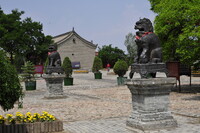Pagoda of Fogong Temple
unknown (Chinese)

Download1A2-CH-D-PFT-D20_cp.jpg (544.1Kb)
Alternative Titles
佛宫寺释迦塔
Mu ta (Timber Pagoda)
Date
1056Description
Chinese guardian lion (shishi), in temple context (foshi, Buddha's lion), bronze pair placed in the plaza behind the pagoda (north); Also called the Mu ta (Timber Pagoda) or Fogong si. One of the extant buildings of the Liao dynasty, a Northern Chinese dynastic period dating from 907 to 1125; it was founded by the proto-Mongolian and nomadic Khitan people. Liao architecture displays Tang influence and an adherence to Buddhism. The pagoda is dedicated to Shakyamuni Buddha. The pagoda stands on a 4 m (13 ft) tall stone platform, has a 10 m (33 ft) tall steeple, and reaches a total height of 67.31 m (220.83 ft) tall; it is the oldest existent fully wooden pagoda still standing in China. The wide, octagonal, five-story (exterior) structure is somewhat squat. The compact bracket system supporting the steeply sloping and projecting eaves is fairly sophisticated, and flying rafters are employed throughout. The structure is unique: its six layers of exterior eaves conceal its interior construction: five interior colonnaded floors and four perimeter galleries, topped by a roof level. Moreover, 56 different bracketing formations have been identified, many of which correspond to illustrations in the Yingzao fashi of 50 years later. Source: Grove Art Online; http://www.oxfordartonline.com/ (accessed 7/31/2012)
Type of Work
temple; pagoda (building)Subject
architecture, deities, Buddhist, Buddhism, Liao
Rights
Rights Statement
Licensed for educational and research use by the MIT community only